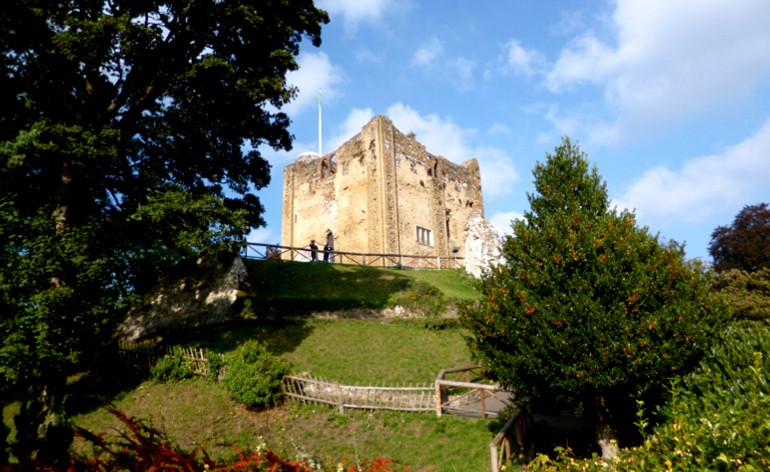Standing high upon the hill, looking down over the town as it has done for almost one thousand years, Guildford Castle is the second oldest structure in Guildford, behind the tower at St. Mary’s Church (although the rest of the church building is much more modern). Though it has long stood in ruin, the ‘keep’ still retains much of its regal grandeur, nestled amongst lavishly beautiful gardens that remain free and open to the public as they have done for over 120 years.
It is hard to imagine how the original castle would have looked like when it was first built, especially since it changed so much during the years that it was still in use. Guildford Castle is believed to have been built by William the Conqueror, around the years 1066-1071, though it is hard to find precise records from that time. Guildford was a clear choice for the site of a castle as William sought to strengthen his hold over Britain, preventing rebellion by building castles in towns all over the country. Guildford, at the time, was the only town in Surrey apart from Southwark, and a vitally important stop on the route between London and the South and West of England.
The first structure would not have been the great stone castle keep we are familiar with today, but a very basic Bailey and Motte (mound and courtyard) castle. The boundary would have run along what is now Castle Street, South Hill and the edge of Racks Close, running parallel to Quarry Street. The stone keep was not built until the twelfth century, perhaps around the 1130s, although it is hard to tell for certain.
In the late twelfth century the great tower was built of stone gathered from the Godalming area; it was a two-storey keep with the entrance placed on the first floor, both for status and defence. It is believed that the great tower was originally used as the king’s private apartments. However, when a better living space was built within the bailey, the king moved from the tower and it was instead given to the sheriff. The sheriff then used the tower both as his headquarters and as the county gaol. It is difficult to imagine the now crumbling and decaying keep housing the contemporary prisoners of Sussex and Surrey when the building was fully functional.
Though Guildford Castle was used mainly as a dwelling, it was greatly fortified and very strongly defended. It was strengthened again around 1173-1174, during the rebellion of King Henry II’s son, even though it was never actually attacked.
In 1216 the castle was given up without a fight to the armies who supported the barons that rebelled against the infamously petty and cruel King John. So even in tumultuous times, during which the countryside was ravaged by civil war, Guildford Castle remained untouched by conflict.
It was during the twelfth century that the castle went from the basic bailey and motte design to a palace, after many lavish changes were undertaken by King Henry III. Queen’s apartments were added along with luxurious decor and Guildford Castle became a true palace as we understand the word today. However, in 1254, a fire damaged the great hall and several other buildings, however, this did not halt developments.
By the time the fourteenth century had rolled around, Britain found itself enjoying relative domestic peace. Guildford Castle and other inland castles were no longer required as they once had been and so it was left to fall into disrepair. In just a short time, the once great palace that had housed royalty for centuries, had fallen into ruin, nothing remained but the king’s great chamber. Instead of residing in Guildford Castle, visiting royalty instead stayed in a newly built hunting lodge on the opposite side of the River Wey.
The great tower continued to be used as the county gaol, however it was moved to Southwark in the early sixteenth century and so John Darborne was made keeper and warden of the garden. The Daborne family remained involved with the castle and its grounds for the remainder of the sixteenth century.
At the beginning of the seventeenth century the castle was given to Francis Carter. The roof was removed in 1630 and the tower was used as a cockpit. Along with parts of the ground being auctioned off and other parts privately rented, Guildford Castle was unrecognisable from just a few centuries before.
The castle was run this way until 1885, when Lord Grantley of Wonersh sold the castle and the large part of the grounds that he owned, to the Guildford Corporation. It was then that restoration began on the tower and other walls, with extensive work also being done on the grounds. In 1888 it was opened up to the public as a pleasure gardens. After this the castle enjoyed a period of consistency while Guildford grew and evolved around it, with the residents now able to enjoy the peace and beauty brought to them by the stunning gardens.
The great tower remained without a roof until fairly recently and so the interior of the castle was subjected to as much of a battering from the elements as the outside was. Then in 2003 restoration work began once again. The tower was conserved, with original crenulations and other features being discovered along the way; each new discovery illuminating more of the castles’ long history. The roof and floor were reinstalled at the first floor level and so once again the interior was protected from the unforgiving weather.
There is now a scale model of how the castle is believed to have once looked on the ground floor today. This finely detailed model is based on what little records there are available from the time, and knowledge of similar such castles that have remained more intact. Panels of information line the walls, so that any visitor can learn the rich history of the castle for themselves. A staircase leads up to the first floor on the outside, to allow visitors to explore the keep to the very top, passing walls that once witnessed the lives of the royalty housed within.
The award winning grounds are still exceptionally beautiful, vibrant in the summer and comforting in the winter, and they are still free to enjoy, whether you are a Guildford resident or just a day tourist. Guildford Castle is an essential focal point of Guildford and its history, and visitors may find themselves struck by both awe and admiration of its timeless beauty.
Charli Aisha Harris



